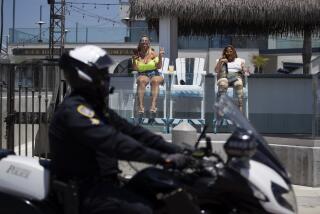A Reporter’s Contribution to the Latino Movement
- Share via
Once the riot broke out, all I remember is the chaos and fear. People screaming and scattering. Clusters of cops and civilians flailing at one another. Looters smashing shop windows.
We had driven from Berkeley to Los Angeles to participate in the National Chicano Moratorium, a protest against the disproportionate number of Latinos dying in the Vietnam War. Suddenly, we found ourselves in the middle of a war right here at home.
We weren’t street fighters. We were just college students with a cause who had held a party to paint signs and banners for another protest--one that turned out to be the largest Mexican American demonstration in U.S. history.
We joined a march, 20,000 strong, along Whittier Boulevard on that hot and hazy Aug. 29, 1970. Then we rallied peacefully at a park that would be memorialized as a result of the tragedy that was about to unfold.
Laguna Park would be rechristened in honor of a Los Angeles Times columnist who was in the crowd that Saturday afternoon. Many of us who didn’t live in Southern California didn’t know the newsman at the time. But from that day forward, the name Ruben Salazar would become inextricably tied to the cause he was covering.
When the tear gas and confusion cleared, the memory of the slain newsman emerged as a galvanizing symbol of the Latino fight for equality and full participation. But the demonstration also marked a turning point in the tactics of the movement, from attacking the establishment to working within it.
Some of the protesters on the street that day went on to win important political posts. And groups of Latino professionals started to emerge, such as the California Chicano News Media Assn. started by Salazar’s colleagues in his honor. Ironically, friends and associates say Salazar’s personal politics seemed to be going the other way, from mainstream to more radical.
Salazar was a seasoned newsman who had covered foreign wars and riots before being called back to report on the burgeoning civil rights movement among Latinos in Los Angeles.
He had covered the U.S. invasion of the Dominican Republic in 1965, and later reported on the escalating war in Vietnam. As Times bureau chief in Mexico City, he witnessed the violent student demonstrations of 1968 that threatened to derail the Olympic Games and destabilize the Mexican government.
But ironically, Salazar died while on assignment at home. Early in 1970, he had become news director for KMEX, the city’s Spanish television station. And he had agreed to continue contributing to The Times as a weekly columnist on Latino affairs.
Salazar had reported aggressively about police brutality in the barrios and expressed foreboding to colleagues about his safety on the streets.
During the riot, he and his crew stopped to rest at the Silver Dollar Cafe on Whittier Boulevard. Salazar ordered a beer; he never left alive.
Responding to reports that a man with a rifle had entered the bar, sheriff’s deputies fired a tear gas projectile through a curtained doorway. The bullet-shaped canister hit Salazar in the head, killing him instantly. He was 42.
*
Salazar became an instant martyr to Chicano activists, some of whom still harbor conspiracy theories about his death. To young journalism students like me at the time, he became a model of professionalism and achievement.
Those who knew Salazar say the mantle of martyrdom doesn’t suit this earthy, easygoing man who jokingly lapsed into barrio slang and sometimes drank too much. In fact, some of those who lionized him in death had criticized him in life as a sell-out who had an Anglo wife and a middle-class home with a swimming pool in suburban Orange County.
Salazar considered himself first and foremost a journalist and resisted being labeled a Mexican reporter. The irony is that he was so effective as a writer that he couldn’t help becoming, once he was gone, a symbol for the aspirations of the Latino community he chronicled.
“Salazar’s death was a devastating loss to a community that was just starting to find its voice,” wrote Frank del Olmo, a Times editor who knew Salazar, in a remembrance for a 1997 media journal. “. . .For he seemed to be taking not just his own journalism but that of The Times to a new level that matched the passion being expressed on the city’s streets.”
Salazar was a groundbreaking journalist who wrote about the most critical issues of the day--poor education, unequal opportunity, police brutality. Almost 30 years later, many of those same problems are still a part of Latino life in the United States.
But today, there are many more Latinos working in newsrooms across the country, including at the Los Angeles Times, where I now write a column on Latino affairs. In the panic of that dreadful day in East L.A., this scared student journalist never dreamed he would be working one day in Salazar’s place.
Looking back, it’s clear that he opened the doors.
More to Read
Sign up for Essential California
The most important California stories and recommendations in your inbox every morning.
You may occasionally receive promotional content from the Los Angeles Times.










